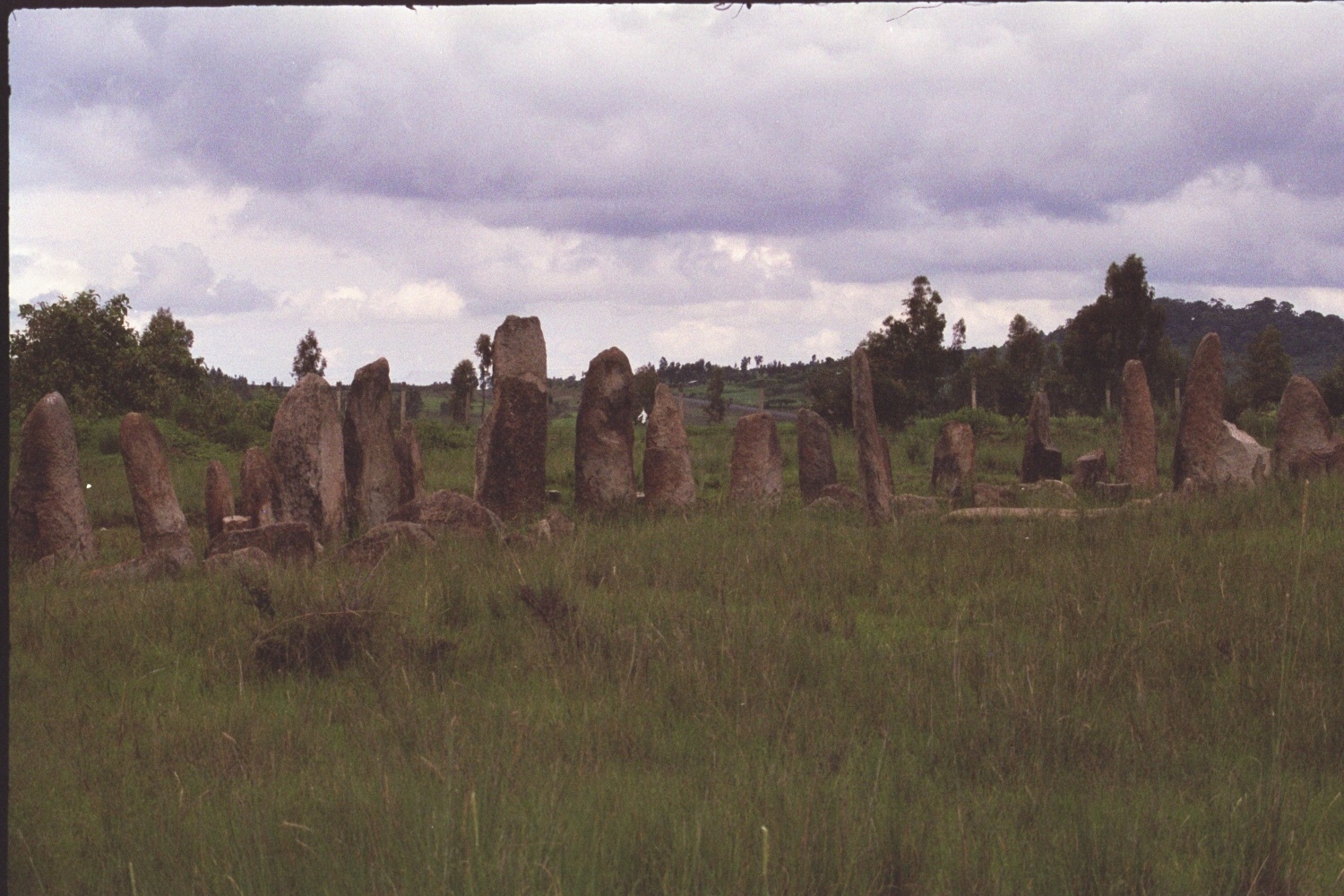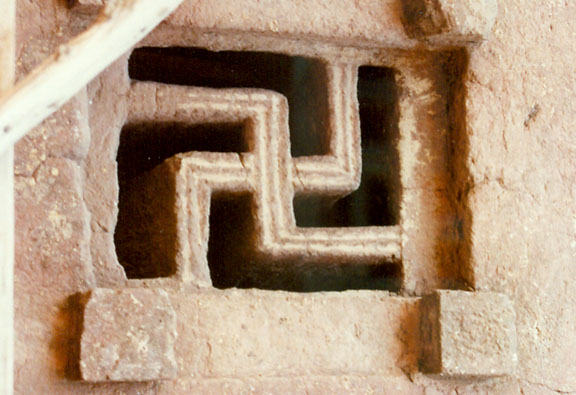An Unwritten History of Ethiopia
An unwritten history of Ethiopia
Unlike much of Africa, there is very little evidence of cave painting within what is now Ethiopia. Instead the best known example of pre-historic art is the stelae at Tiya. These are carved stones set up in an area with graves nearby, leading archeologist to believe there is a correlation between these stones and they dead. This ancient site looks much like Stonehenge in Britain, but these stones have carvings on them. (1)
CC-BY-SA |other_versions (http://www.flickr.com/photos/mrflip/36813273)], via Wikimedia Commons
https://commons.wikimedia.org/wiki/File:Tiya_stelae.jpg#file
There are a few cave paintings located in the mountainous areas. These consist mainly of paintings of livestock,lions, and by some accounts even script. Many have been severely damaged by both the elements, because salt and water mix together to wear away the surface of the stone, and by locals.
You can find a few pictures here of Prehistoric cave art in present day Ethiopia. (2)
The history of Ethiopia is tied up in many ways with it’s religion. Some of the best examples of ancient art that we find in Ethiopia are churches carved into caves. These church were created in the 13th century. Not only are they a beautiful representation of art in Ethiopia, but they do much to further our understanding of the history, culture, and religious movement that has occurred in this country. There are eleven churches carved from the rock, including the windows and doors. These are centralized on the Ethiopian town of Lalibela. (3)
CC-BY 2.0 (http://creativecommons.org/licenses/by/2.0)], via Wikimedia Commons https://commons.wikimedia.org/wiki/File%3AChurch_of_Bet_Abba_Libanos%2C_Lalibela%2C_Ethiopia_(3328424359).jpg
By Samzhab [CC-BY-3.0 (https://commons.wikimedia.org/wiki/File%3ASkastika_symbol_in_the_window_of_Lalibela_Rock_hewn_churches.jpg)
This prevalence of religion from early on in Ethiopia is also seen within it’s music. Although there are a wide variety of musically styles because of the wide range of space which Ethiopia now covers, there are many Christian elements found in some of the music. Musicians in Ethiopia are highly respected due to their traditional role as storytellers and in their own way, historians. There are also several instruments used in the country which help to convey the story. (4)
It can be difficult to find true traditional music. Many sources have traditional instruments played with a modern influence. This is an excellent piece that I believe shows a more accurate depiction of what the music of ethiopia sounded like long ago. (5) This is an example of an instrument from Ethiopia, this instrument happens to be quite different than the one played in the video.
By KarlHeinrich Public Domain (https://commons.wikimedia.org/wiki/File%3A%C3%84thiopien_Kirchentrommel_Linden-Museum_21084.jpg)
Because of the early prevalence of coptic writings, mainly for religious purposes, Ethiopia has a had a unique oral-history tradition. In some portions of the history we are able to see consistency with the written history and the oral traditions passed down. (6)
The flag of Ethiopia has changed over time as well, and yet still has connections with the religion of the area. The first flag to be connected to Ethiopia in resent times is similar to what we see today. It had the same panels of green, yellow, and red. Yet it is different, because there was a Lion of Judah on the flag.
By Kwasura Public Domain (https://commons.wikimedia.org/wiki/File%3AFlag_of_Ethiopia_1974.gif)
This lion was present when there was an emperor in Ethiopia and has since been changed many times over.(7) The lion is called the lion of Judah and reflects the Christian heritage that is strong in Ethiopia. The colors have remained the same, sometimes shaped as a pennant, but most often as a traditional rectangular flag. Today there is an emblem of a yellow star on a blue circle in the center of the flag representing unity and peace within the country.
By -Public Domain (http://www.ethiopar.net/type/Amharic/hopre/bills/1998/654.ae..pdf)
Ethiopia was never fully colonized by a European country, and the flag does not reflect a European tone, (although during Mussolini’s time there was a takeover of the country which still effects Ethiopia today.)(8) The changes in the flag are significant, because they often occur when a change of power has occurred within the leadership at Addis Ababa, the capital of Ethiopia.
(1) African World Heritage Sites. "Tiya- Ethiopia." Rock-art & Pre-history.
Copyright 2011. Accessed July 14, 2016. http://www.
africanworldheritagesites.org/cultural-place/rock-art-pre-
Copyright 2011. Accessed July 14, 2016. http://www.
africanworldheritagesites.org/cultural-place/rock-art-pre-
history/tiya.html
(2) Tesfay, Gigar. "Rock Art around Zalanbesa Area in the Eastern
Zone of Tigrai (Ethiopia)." Annals
Zone of Tigrai (Ethiopia)." Annals
d'Ethiopie 16, no. 1 (2000): 89-92 Accessed July 14, 2016.
http://www.persee.fr/doc/ethio_0066-2127_2000_num_16_1_963
(3) UNESCO World Heritage Centre. "Rock-Hewn Churches, Lalibela."
2014. Accessed July 14, 2016.
2014. Accessed July 14, 2016.
http://whc.unesco.org/en/list/18
(4)"Music of Ethiopia". (Accessed July 14, 2016.
https://en.wikipedia.org/wiki/Music_of_Ethiopia)
https://en.wikipedia.org/wiki/Music_of_Ethiopia)
(5)Youtube. "Ethiopian Music:Asnakech Worku." DiggerHabesha.
Published January 28, 2013. Accessed
Published January 28, 2013. Accessed
July 15, 2016 https://www.youtube.com/watch?v=aDpNyGOxuxs
(6) Quirin, James. "Oral Traditions as Historical Sources in Ethiopia:
The Case of the Beta Israel (Falasha)." History in Africa,
Vol. 20 (1993), pp. 297-312. Accessed July 13, 2016. Stable
The Case of the Beta Israel (Falasha)." History in Africa,
Vol. 20 (1993), pp. 297-312. Accessed July 13, 2016. Stable
URL: http://www.jstor.org/stable/3171976
(7) "The Mysterious Origins of the Flag of Ethiopia" Ethinopedia
or Encyclopedia for Ethiopia, January
or Encyclopedia for Ethiopia, January
1, 2007. Accessed July 14, 2016. http://ethiopedia.
blogspot.com/2007/01/mysterious-
blogspot.com/2007/01/mysterious-
origin-of-flag-of-ethiopia.html
(8) "Italians of Ethiopia". (Accessed July 14, 2016. https://
en.wikipedia.org/wiki/Italians_of_Ethiopia)
en.wikipedia.org/wiki/Italians_of_Ethiopia)

.jpg)




Comments
Post a Comment